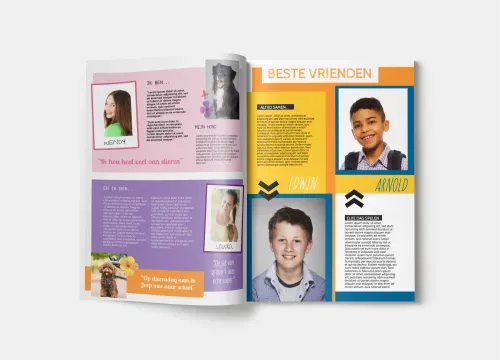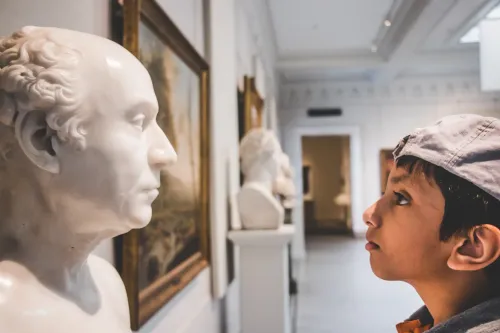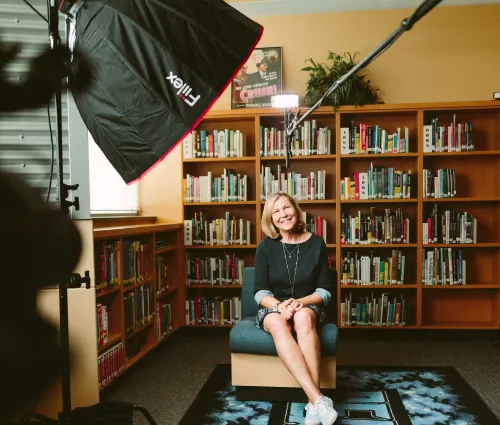History, Dutch and art subjects in one magazine. Second year high school students at the Liberal-Christian Lyceum Highschool in the Hague, Netherlands combined three subjects into one project. Coordinated by their history teacher, Mirjam Zeilmaker, they created a magazine called 'The Golden Age Project'. Mirjam enlisted the help of her colleagues for this project, and she explains why:
"This project enables students to hand in one magazine containing all the required works for history, Dutch and art. We graded the magazine for all three subjects. The reason we chose to do it this way is because it saves the students a lot of time. They're already swamped by so many exams over the course of the year, and this magazine project removes a great deal of workload. Plus, it's a nice change from the way things are usually done."
Creating a magazine is a large project with a lot of small moving parts. To a 13 or 14 year old, the scale of this project may seem daunting, but Mirjam knew how to handle it:
"You explain to students that we're going to do it step-by-step and over the course of a few weeks, so we have time. As long as you keep up with the schedule and update your own schedule accordingly, it will all sort itself out. The result is your own Golden Age Magazine."
Make and use a step-by-step guide book
The students created the magazine over the course of 6 weeks. By creating a step-by-step guide book, Mirjam was able to provide all the information the students would need to complete their magazine. The guide book not only helped students complete exercises pertaining to each subject, but also taught them how to plan accordingly.
- The guide book contains:
- History, Dutch and Art exercises
- Schedule with weekly tasks
- Timetable example
- Instructions on how to use Jilster
While creating a step-by-step guide book, Mirjam also tried the makerspace out for herself first:
"Doing this allowed me to write out clear instructions on what to do and what not to do for my students. I tried to get their creative juices flowing by showing them a few example pages I had made myself, and telling them to check out some magazines at home, in stores, and to bring magazines into class."
The project in action
Overall, the magazine was graded on content for history, spelling and grammar for Dutch, and design and creativity for art.
For Dutch class, the students had to read a book from a book list and write a book report. They also wrote a letter, consisting of at least 300 words, to the book publisher. Students were also allowed to read the chosen book during the first ten minutes of every history and dutch class leading up to the assignment deadline.
Dutch class magazine project assignments:
- Book report
- Letter to publisher
For history, they created a project that combined historical events with people in present day Netherlands. Michiel Adriaenszoon de Ruyter was a Dutch admiral. He was one of the most skilled admirals in history, most famous for his role in the Anglo-Dutch Wars of the 17th century. His descendant Frits de Ruyter, currently lives in The Hague, so the school had the opportunity to visit him for a day and listen to a presentation about his forefather and his family history.
A few of the students were tasked with organising this event themselves. A few other history assignments included seeing a historical movie, visiting a museum, writing a review about both, and adding a recipe for a dish from the Golden Age.
History class magazine project assignments:
- Organizing an event with a speaker that can give a presentation on historical events
- Attending a presentation on a famous historical figure
- See and review a historical movie
- Visit and review a museum
- Look up historical dishes and add a recipe
Lastly, a magazine project wouldn't be complete without creativity and design elements. The students got to work on the magazine cover during art class. Another assignment for art was to recreate a historical painting using themselves, classmates, family and/or friends.
What are the students saying?
When we asked students about the project, Juliette and Liam were excited to shared their experiences.
"We mostly use books at school, not computers. This magazine project has allowed us to use computers as well. It has taught us so much more than the books by themselves, like working with different computer files, for example."
Juliette especially mentioned to us that she enjoyed using the templates. "The templates are really helpful. Using these in your magazine gives you a good base to start with. Templates make it easy to create a recurring theme too. I also liked that we were able to work on the magazine at home. Jilster was fun to work with, not like regular homework."



